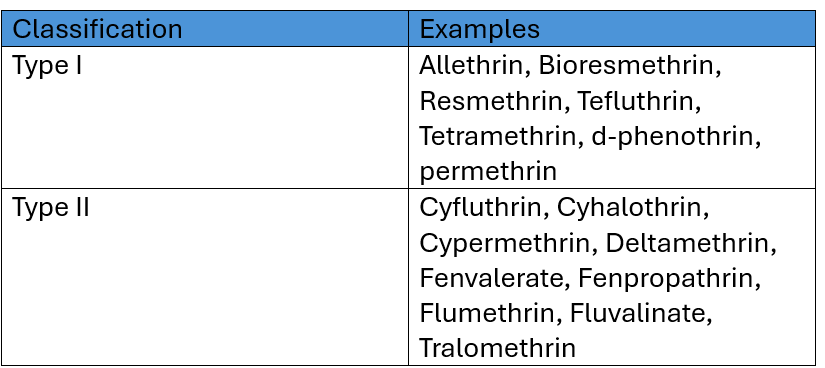THE PYRETHROID WATCH- A COMMON PESTICIDE IN YOUR HOUSE
- Pyrethroids are pesticides used against common household pests
- It is present in mosquito repellants and are used extensively in households
- Pyrethroids are synthetic derivatives of pyrethrins which are collected from Chrysanthemum flowers.
- Pyrethroids are neurotoxic to insects, and they are lipophilic.
- Being lipophilic helps these chemicals to penetrate through exoskeleton.
Classification

Type II pyrethroids have an alpha-cyano moiety (but features of cyanide poisoning have not been reported)
Mechanism of action

In vitro, pyrethroids have an effect on
- Voltage-gated sodium channels
- Voltage-gated calcium channels
- Voltage and ligand gated- chloride channels
- The GABA receptor-chloride ionophore complex
Type I pyrethroids – produce repetitive discharges (burst discharges) for a single stimulus
Type II pyrethroids – prolongs the period of depolarization
Pyrethroids often contain additives like piperonyl butoxide and organophosphate compounds
Toxicokinetics
- Absorbed orally and by inhalation
- Less readily absorbed through skin
- Rapidly redistributed as they are lipophilic
- Metabolized in liver
- Eliminated through urine
- Metabolites: 3-phenoxybenzoic acid(3BPA) – Nonspecific
- cis-3-{2,2-dichloroethenyl}-dimethyl cyclopropane carboxylic acid (cis-DCCA) – cis permethrin, cypermethrin, cyfluthrin
- trans- DCCA – trans-permethrin, cypermethrin, cyfluthrin
Clinical features
- Lethal dose – 1g/Kg
- Pyrethroids can mimic organophosphate poisoning
- Type I pyrethroids – T syndrome – tremors, incoordination, twitching, prostration, increased metabolic rate, hyperthermia, seizures, death.
- Type II pyrethroids – CS syndrome (choreoathetosis syndrome)- hyperactivity, paresthesia, hunched back, salivation, tremors, incoordination, sinuous writhing movements, altered mental status, seizures come, acute lung injury.
- Ocular exposure – mild irritation, miosis.
- Skin exposure – paresthesia, pruritic, erythema, burning, blisters.
- Inhalational exposure- sneezing, coughing, rhinorrhea, shortness of breath, wheezing.
- Cardiotoxicity is rare but reported. ECG findings: sinus tachycardia, ventricular ectopic, ST and T wave changes and rarely sinus bradycardia.
Biochemical findings
- Metabolic acidosis
- Normal choline esterase level
- Leukocytosis
- Raised AST
- Raised serum creatinine
Management
- No antidote
- Gastric lavage (if presented to ER within 1 hour)
- Activated charcoal 50-100g (adult)
- Atropine if symptomatic bradycardia
- Supportive management




